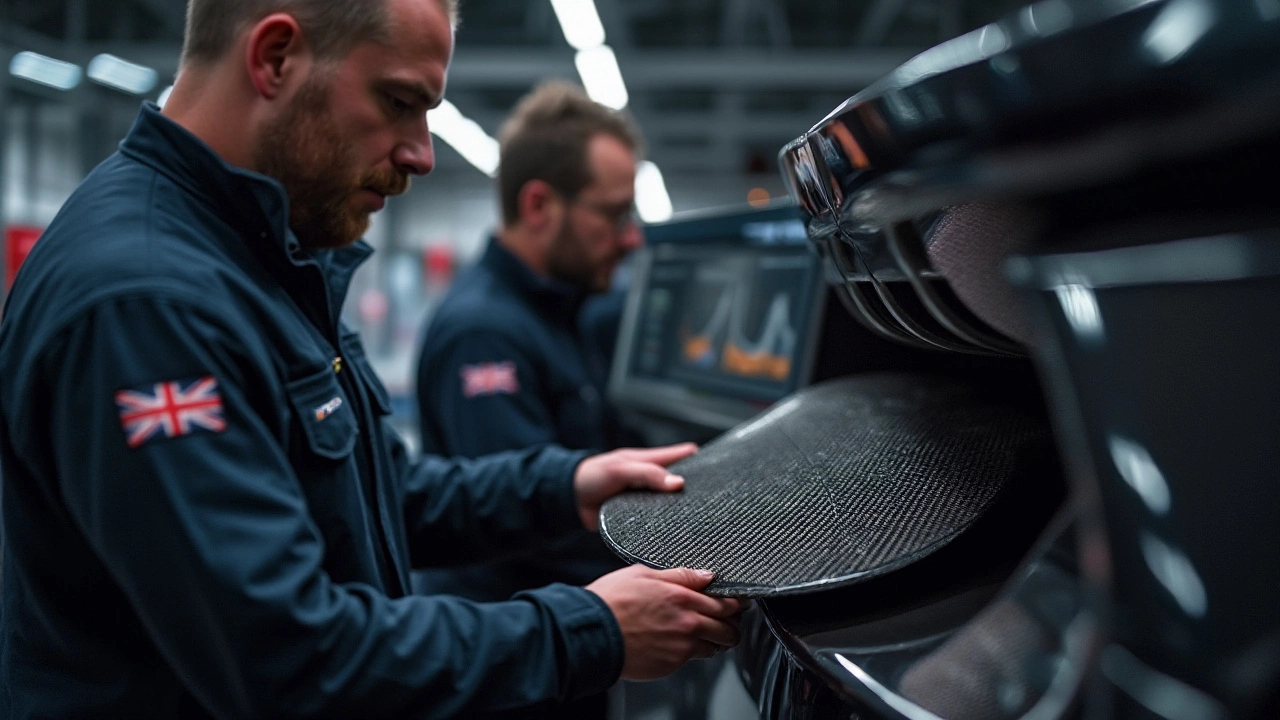In the realm of automotive engineering, few components have as much allure and misunderstanding as the spoiler. These intriguing appendages, particularly when hewn from lightweight carbon fiber, aren't just about adding a sporty flair to a vehicle’s silhouette. They serve a much more dynamic purpose.
But at what speed does the magic happen? When does a spoiler graduate from being mere ornamentation to a critical player in the physics of motion? The answers lie in a blend of fluid dynamics and practical engineering – areas where art meets science on the open road. Join us as we navigate through these concepts, unpacking the true essence of what makes spoilers not just effective, but essential at certain speeds.
- Understanding Spoilers and Aerodynamics
- The Role of Carbon Fiber in Performance
- Speed Thresholds for Effectiveness
- Real-world Applications and Benefits
- Selecting the Right Spoiler for Your Vehicle
Understanding Spoilers and Aerodynamics
Spoilers are not just flash pieces of equipment glued to the back of slick sports cars; they are marvels of engineering specifically designed to improve vehicle performance by manipulating airflow. The primary purpose of a spoiler is to 'spoil' unwanted motion, specifically that of air coming over the top of a vehicle. As vehicles increase in speed, air pressure can lift the back of a car, reducing the tire grip on the road—a scenario nobody wants when curving around bends or when high-speed precision is critical. So how does a carbon fiber spoiler come into play here?
The spoiler works as a tool to combat the negative lift generated by the airflow over the car. Unlike airplane wings, which are built to enhance lift, spoilers operate in opposition, redirecting the flow of air to press the car more firmly to the ground. This is known as creating 'downforce.' Although the material—often carbon fiber for its strength and lightness—adds almost negligible weight, it marks a significant impact on how a car 'hugs' the track, increasing traction and thus enhancing control.
Aerodynamic concepts utilized by spoilers center around complex principles: drag and downforce. One brilliant mind in the realm of aerodynamics, Simon McBeath states,
"Aerodynamics is the invisible mastery behind both safety and performance in automotive design. Every inch can control the nature of a car in motion."The drag coefficient is crucial because it represents the resistance a car experiences while moving through air. An optimized spoiler can reduce this drag, enabling smoother cruising and less fuel consumption. For car enthusiasts who relish track days or simply enjoy the mechanics of vehicular physics, the efficiency of a well-engineered spoiler becomes more than just a boost in speed—it's a core element of stability and control.
In terms of real-world applications, spoilers are effective at a range of speeds, but their use truly shines on highways and tracks where speed is significant enough to exploit these aerodynamic advantages. Surprising as it may be, not all cars need spoilers; a commuter vehicle rarely benefits from such enhancements unless it's pushing the velocity boundaries that could generate destabilizing lift forces. Thus, the placement and shape of a spoiler have to be meticulously tested in wind tunnels, simulations, and real-world driving to ensure they benefit a specific model and its typical use case.
Ultimately, coupling aerodynamic finesse with state-of-the-art materials like carbon fiber, spoilers provide an invaluable addition to high-performance vehicles. They do more than amplify a vehicle's aesthetic appeal; they potentially heighten its ability to perform and ensure driver safety at high speeds. Understanding this allows us to appreciate the engineering precision behind each spoiler's design, as well as the strategy in its structural integration onto our most beloved machines.
The Role of Carbon Fiber in Performance
In the pursuit of speed and efficiency, carbon fiber spoilers have emerged as a remarkable advancement in automotive engineering. Their utilization in vehicles is not merely for aesthetic enhancement; their true value is rooted in their robust performance capabilities. Carbon fiber is known for its incredible strength-to-weight ratio, providing a level of rigidity and lightness unmatched by traditional materials such as metal or plastic. This unique composition allows for better handling and increased speed, since the less a vehicle weighs, the less force is required to propel it forward. This in turn impacts fuel efficiency positively—a win-win for both performance enthusiasts and environmentally conscious drivers.
The magic of carbon fiber lies in its structure. Made from thin strands of carbon, each much thinner than a strand of human hair, these strands are woven together to create a fabric which is then set in hard resin. The result is a material that excels in both compressive and tensile strength. This makes it an ideal candidate for producing spoilers that endure incredible stress while maintaining shape and function. A carbon fiber spoiler strategically alters airflow to reduce air resistance and provides increased downforce, thereby stabilizing the vehicle at higher speeds.
Despite its many benefits, carbon fiber incurs significant costs due to complex manufacturing processes. From the weaving of fibers to the molding and curing, each step must be meticulously controlled, making it one of the most expensive materials available. Yet, for enthusiasts and professionals alike, the payoff in terms of enhanced performance justifies this expense. According to the McLaren Automotive CEO, "Carbon fiber has transformed our approach to maximizing vehicle performance while keeping a keen eye on sustainability."
In a technical sense, carbon fiber affects the aerodynamic efficiency of the vehicle. As a car accelerates, air flows over its surface and generates lift—a phenomenon that can impede traction and stability. The integration of a carbon fiber spoiler changes this dynamic by disrupting the airflow in a way that presses the vehicle downwards, counteracting lift. This increased traction is critical during rapid acceleration and sharp cornering, where every bit of grip can make a dramatic difference.
Applications of carbon fiber aren't just confined to high-end sports cars or racing vehicles. With technological advancements and increasing demand, more automakers are exploring its integration into everyday cars, creating a trickle-down effect where consumers can enjoy the benefits without breaking the bank. The clever use of carbon fiber not only boosts the heart rates of car enthusiasts but also signals a shift towards greater fuel economy and emission reductions. Carbon fiber represents the future of performance, highlighting that the conflation of lightweight design and strength need not come at the cost of practicality or affordability.

Speed Thresholds for Effectiveness
Understanding the speed at which a spoiler becomes effective is crucial for anyone serious about maximizing their vehicle's performance. Spoilers are all about dynamics—altering the airflow to improve a car’s traction and stability. The magic starts to happen in earnest around speeds of 60 miles per hour. At this point, the aerodynamic demands of the vehicle mean that the spoiler starts to play its pivotal role. It's not just information from textbooks—this threshold is backed by real-world testing. Car manufacturers and testing companies often utilize wind tunnels to determine this threshold, adjusting for variables like car weight, design, and spoiler size.
So, why 60 mph? It's about downforce and drag, two pivotal aerodynamic forces in play. As a car accelerates, air pressure on top of the car decreases while pressure underneath increases, causing lift, which reduces traction. By pushing the rear of the vehicle down, a spoiler counteracts this lift. This makes a significant difference on highways and race tracks where vehicles often sustain speeds beyond 70 mph. Such speeds are transformative for vehicles sporting carbon fiber spoilers, known for their light weight and strength, allowing for a minimalistic design without sacrificing function.
The effectiveness can also vary with the design of the spoiler itself. Testing on the Bonneville Salt Flats often sees cars equipped with exaggerated wing spoilers that start showing benefits at even lower speeds due to their sheer size and angle. However, street-legal vehicles benefit from subtler designs that promise efficiency at attainable speeds. According to a study by Automotive Aerodynamics Research Group, a rear spoiler can reduce a car's drag by up to 3.5%, leading to better fuel efficiency and enhanced control during turns.
"Aerodynamics are for people who can't build engines," famously quipped Enzo Ferrari. Yet, even he would agree that no amount of engine power could compensate for lack of control at high speeds. Spoilers are vital.
Enthusiasts and daily drivers alike should note that a spoiler’s influence grows exponentially with speed. However, effectiveness can diminish at low speeds, often below 50 mph, where the aerodynamic lift and drag are relatively negligible. Around the city or during daily errands, a spoiler's impact might only be noticed aesthetically or slightly impacting fuel efficiency due to its weight and drag, particularly in older designs not crafted from carbon fiber.
Indeed, the allure of adding a spoiler is understandable, but its true potential shines on open roads or track days. Consider your needs and driving habits before investing in this performance upgrade. Remember, a well-selected spoiler paired with practical driving can transform your experience both in terms of vehicle handling and aesthetic appeal.
Real-world Applications and Benefits
When it comes to automobiles, the utility of carbon fiber spoilers is as varied as it is profound. These aerodynamic enhancements are not mere eye-candy. They provide real-world performance benefits that stand out prominently at high speeds, particularly on highways and race tracks. In racing, spoilers help achieve higher cornering speeds by enhancing the traction of the rear wheels, a necessity when fractions of a second can be the difference between victory and defeat. For everyday drivers, especially those who frequent highways or enjoy spirited driving, spoilers contribute to improved stability and fuel efficiency by reducing aerodynamic drag.
The damping effect on lift stands central among the reasons to affix a spoiler. A car moving at speed experiences lift in much the same way as an airplane wing. By disrupting this lift, spoilers ensure that the vehicle remains firmly planted on the road. Studies suggest that the right spoiler configuration can lower the lift coefficient by up to 35%, effectively sticking the car to the asphalt. This translates to more predictable and safer driving dynamics, particularly in agile maneuvers and during emergency braking.
Some car owners install spoilers for the aesthetic touch, yet the advantages extend beyond mere appearances. According to an insider in the automotive industry, "A properly designed spoiler doesn’t just look the part; it actively participates in making the driving experience smoother and more controlled."
"Understanding the aerodynamics behind spoilers can significantly enhance how your car feels on the open road," notes AutoSport Magazine.This blends style with substance, offering a dual benefit of visual and performance enhancement.
In the world of high-speed motorsports, every little advantage counts. Here, carbon fiber spoilers boast an added benefit: weight reduction. Carbon fiber is lighter than traditional materials like aluminum or steel, effectively lowering the vehicle’s center of gravity and improving handling. This is especially crucial in touring and GT racing where rapid directional changes demand nimble vehicles. The lightness of carbon fiber does not compromise its structural integrity; it's uniquely capable of withstanding aerodynamic forces that lesser materials might buckle under.
For the everyday motorist, spoilers can also deliver enhanced fuel efficiency, particularly at speeds over 60 miles per hour. This might seem paradoxical considering the added drag a spoiler introduces. However, by stabilizing airflow and reducing turbulence around the vehicle, spoilers help engines operate more efficiently by requiring less energy to maintain speed. This is an intriguing byproduct of advanced automotive engineering, where slight improvements in design can translate to tangible savings at the fuel pump.
Given these manifold advantages, one might wonder about the overall impact of spoilers on vehicle performance metrics. In tests conducted by various car magazines, cars equipped with rear spoilers reported time reductions in speed-to-distance measurements, enhancing both acceleration feel and braking responsiveness. A spoiler's contribution to reducing lift also aids in minimizing wind noise inside the cabin, providing a quieter and more pleasant driving experience.

Selecting the Right Spoiler for Your Vehicle
Choosing the perfect carbon fiber spoiler for your vehicle is more nuanced than one might initially think. It's not merely a matter of aesthetics but involves a deeper understanding of how different spoiler designs interact with the aerodynamics of your specific car. To maximize both appearance and performance, several factors need careful consideration. First off, the type of car you drive dictates much of what would be the best choice. Sporty coupes and sedans often benefit from more aggressive designs that offer increased downforce, enhancing grip during high-speed cornering. In contrast, lighter, smaller vehicles might not need large spoilers, and in some cases, a subtle lip spoiler can be just as effective without sacrificing the sleek line of the car. There is an art to knowing just how much is enough.
Equally important is the understanding of the intended use. Is your car a daily driver, or do you take it to track days? Daily drivers require a balance between enhancement and practicality. In contrast, track cars can often tolerate more extreme setups, as the environments they're tailored for can exploit their full potential. Additionally, the installation of a spoiler should not compromise the car’s performance; rather, it should enhance it, reducing drag and increasing stability. This is crucial for both professional racers and automotive enthusiasts who regularly push their vehicles to their limits.
Materials also play a significant role. The choice of carbon fiber is often driven by its lightweight properties, reducing the overall weight addition to the vehicle, which is crucial for maintaining speed and efficiency. But beyond weight, carbon fiber possesses a strength-to-weight ratio that is unmatched by most other materials, offering durability that aligns well with the wear and tear experienced at high speeds. In a study conducted by the National Institute for Automotive Service Excellence, it was shown that vehicles equipped with carbon fiber spoilers showed a consistent improvement in aerodynamic efficiency under controlled conditions, substantiating the material’s superiority.
When picking the right spoiler, one should also consider manufacturer ratings and reviews. Brands like APR Performance and Seibon Carbon are renowned for crafting reliable spoilers that have been tried and tested. Michael Schumacher, a Formula 1 legend, once stated, "The smallest details can change the dynamics of a car and make the difference between winning and losing." This couldn’t be truer when selecting a spoiler, as that split-second advantage can translate to measurable improvements in performance and handling.
Finally, consider the customization possibilities. Many owners opt to tailor their spoilers to resonate with their vehicle's design language or personal style preferences. This personalization can be purely aesthetic, but it can also extend to functional enhancements. It's not unusual to see spoilers with adjustable angles, allowing for tweaking based on track conditions or driving styles. When considering a spoiler, one must approach it as a long-term investment in performance and style, ensuring it complements and elevates the vehicle's inherent capabilities.




